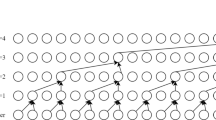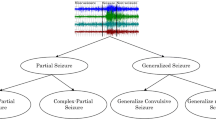Abstract
We purpose a novel method that combines modified frequency slice wavelet transform (MFSWT) and convolutional neural network (CNN) for classifying normal and abnormal heart sounds. A hidden Markov model is used to find the position of each cardiac cycle in the heart sound signal and determine the exact position of the four periods of S1, S2, systole, and diastole. Then the one-dimensional cardiac cycle signal was converted into a two-dimensional time-frequency picture using the MFSWT. Finally, two CNN models are trained using the aforementioned pictures. We combine two CNN models using sample entropy (SampEn) to determine which model is used to classify the heart sound signal. We evaluated our model on the heart sound public dataset provided by the PhysioNet Computing in Cardiology Challenge 2016. Experimental classification performance from a 10-fold cross-validation indicated that sensitivity (Se), specificity (Sp) and mean accuracy (MAcc) were 0.95, 0.93, and 0.94, respectively. The results showed the proposed method can classify normal and abnormal heart sounds with efficiency and high accuracy.

Block diagram of heart sound classification.






Similar content being viewed by others
References
Potes C, Parvaneh S, Rahman A, Conroy B Ensemble of feature-based and deep learning-based classifiers for detection of abnormal heart sounds. In: Computing in Cardiology Conference, 11–14 Sept. 2016. IEEE, pp 621–624
Whitaker BM, Suresha PB, Liu C, Clifford G, Anderson D (2017) Combining sparse coding and time-domain features for heart sound classification. Physiol Meas 38:1701–1713
Langley P, Murray A (2017) Heart sound classification from unsegmented phonocardiograms. Physiol Meas 38:1658–1670
Bobillo ID A Tensor approach to heart sound classification. In: Computing in Cardiology Conference, Vancouver, 2016. IEEE, pp 629–632
Homsi MN, Medina N, Quintero N, Perpiñan G, Quintana A, Warrick P (2016) Automatic heart sound recording classification using a nested set of ensemble algorithms. In: Computing in Cardiology Conference. IEEE, pp 817–820
Abdollahpur M, Ghaffari A, Ghiasi S, Mollakazemi MJ (2017) Detection of pathological heart sounds. Physiol Meas 38:1616–1630
Safara F (2015) Cumulant-based trapezoidal basis selection for heart sound classification. Med Biol Eng Comput 53:1153–1164. https://doi.org/10.1007/s11517-015-1394-4
Wenjie Z, Jiqing H, Shiwen D (2017) Heart sound classification based on scaled spectrogram and partial least squares regression. Biomed Signal Process Control 32:20–28
Baris B, Ioannis G, Yannis S (2018) A study of time-frequency features for CNN-based automatic heart sound classification for pathology detection. Comput Biol Med 100:132–143
Rubin J, Rui A, Ganguli A, Nelaturi S, Sricharan K Classifying heart sound recordings using deep convolutional neural networks and mel-frequency cepstral coefficients. In: Computing in Cardiology Conference, 2016. IEEE, pp 813–816
Han W, Yang Z, Lu J (2018) Supervised threshold-based heart sound classification algorithm. Physiol Meas 39:115011
Cheng XF, Huang JZ, Li Y, Gui G (2019) Design and application of a laconic heart sound neural network. IEEE Access 7:124417–124425
Montesinos L, Castaldo R, Pecchia L (2018) On the use of approximate entropy and sample entropy with centre of pressure time-series. J NeuroEng Rehabil 15:116
Richman JS, Moorman JR (2000) Physiological time-series analysis using approximate entropy and sample entropy. Am J Phys Heart Circ Phys 278:H2039–H2049. https://doi.org/10.1152/ajpheart.2000.278.6.H2039
Liu C, Springer D, Li Q, Moody B, Juan RA, Chorro FJ, Castells F, Roig JM, Silva I, Johnson AEW (2016) An open access database for the evaluation of heart sound algorithms. Physiol Meas 37:2181–2213
Springer D, Tarassenko L, Clifford G (2016) Logistic regression-HSMM-based heart sound segmentation. IEEE Trans Biomed Eng 63:822–832. https://doi.org/10.1109/TBME.2015.2475278
Oki T, Tabata T, Yamada H, Manabe K, Fukuda K, Abe M, Onose Y, Iuchi A, Fukuda N, Ito S (1998) Difference in systolic motion velocity of the left ventricular posterior wall in patients with asymmetric septal hypertrophy and prior anteroseptal myocardial infarction. Evaluation by pulsed tissue Doppler imaging. Jpn Heart J 39:163–172
Cuschieri A, Luo K, Li J, Wang Z (2017) Patient-specific deep architectural model for ECG classification. J Healthc Eng 2017:05–13. https://doi.org/10.1155/2017/4108720
Kan L, Du K, Cai Z, Li J, Wang Z, Cuschieri A A (2018) modified frequency slice wavelet transform for physiological signal time-frequency analysis. In: Chinese Automation Congress. IEEE, pp 3441–3444. doi:https://doi.org/10.1109/CAC.2017.8243375
Xu X, Wei S, Ma C, Kan L, Li Z, Liu C (2018) Atrial fibrillation beat identification using the combination of modified frequency slice wavelet transform and convolutional neural networks. J Healthc Eng 2018:1–8
Yan Z, Miyamoto A, Jiang Z (2011) Frequency slice algorithm for modal signal separation and damping identification. Comput Struct 89:14–26
Lecun Y, Bottou L, Bengio Y, Haffner P (1998) Gradient-based learning applied to document recognition. Proc IEEE 86:2278–2324. https://doi.org/10.1109/5.726791
Clifford GD, Liu C, Moody B, Springer D, Silva I, Qiao L, Mark RG (2016) Classification of normal/abnormal heart sound recordings: the PhysioNet/Computing in Cardiology Challenge 2016. In: Computing in Cardiology Conference. IEEE, pp 609–612
Zabihi M, Rad AB, Kiranyaz S, Gabbouj M, Katsaggelos AK (2016) Heart sound anomaly and quality detection using ensemble of neural networks without segmentation. In: Computing in Cardiology Conference. IEEE, pp 613–616
Antink CH, Becker J, Leonhardt S, Walter M (2016) Nonnegative matrix factorization and random forest for classification of heart sound recordings in the spectral domain. In: Computing in Cardiology Conference. IEEE, pp 809–812
Goda MA, Hajas P (2016) Morphological determination of pathological pcg signals by time and frequency domain analysis. In: Computing in Cardiology Conference. IEEE, pp 1133–1136
Leal A, Nunes D, Couceiro R, Henriques J, Carvalho P, Quintal I, Teixeira C (2018) Noise detection in phonocardiograms by exploring similarities in spectral features. Biomed Signal Process Control 44:154–167
Funding
This work was supported by Shandong Province Key Research and Development Plan (2018GSF118133); China Postdoctoral Science Foundation (2018M642144); and the China Postdoctoral Science Foundation under Grant (2017M612280).
Author information
Authors and Affiliations
Corresponding authors
Ethics declarations
Conflict of interest
The authors declare that they have no conflict of interest.
Additional information
Publisher’s note
Springer Nature remains neutral with regard to jurisdictional claims in published maps and institutional affiliations.
Rights and permissions
About this article
Cite this article
Chen, Y., Wei, S. & Zhang, Y. Classification of heart sounds based on the combination of the modified frequency wavelet transform and convolutional neural network. Med Biol Eng Comput 58, 2039–2047 (2020). https://doi.org/10.1007/s11517-020-02218-5
Received:
Accepted:
Published:
Issue Date:
DOI: https://doi.org/10.1007/s11517-020-02218-5




